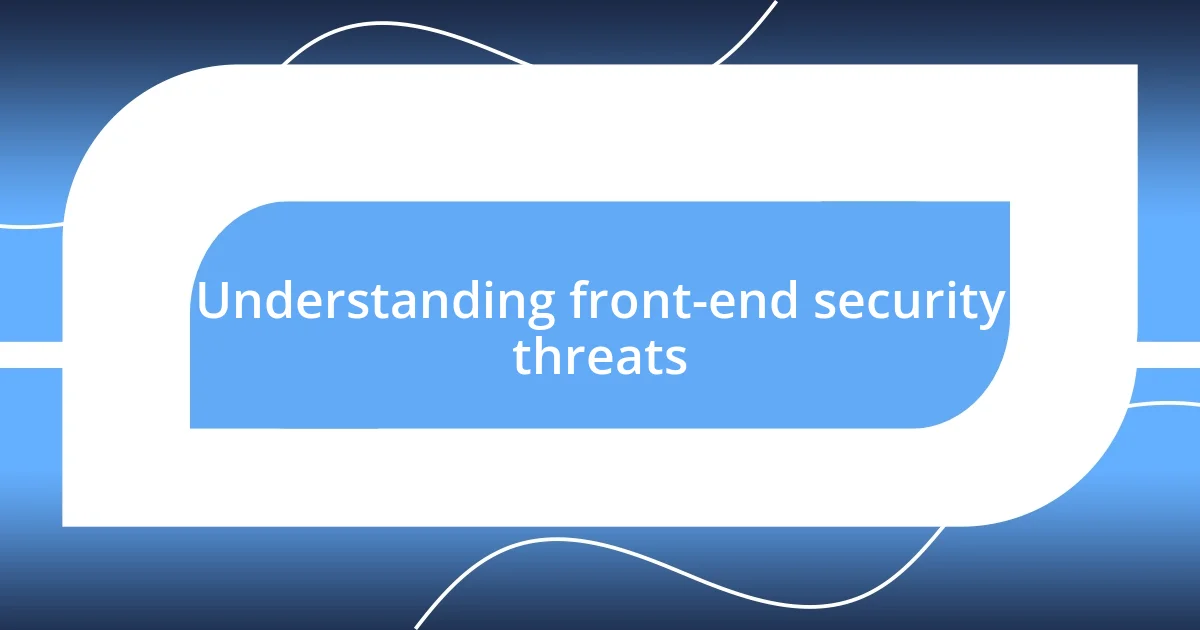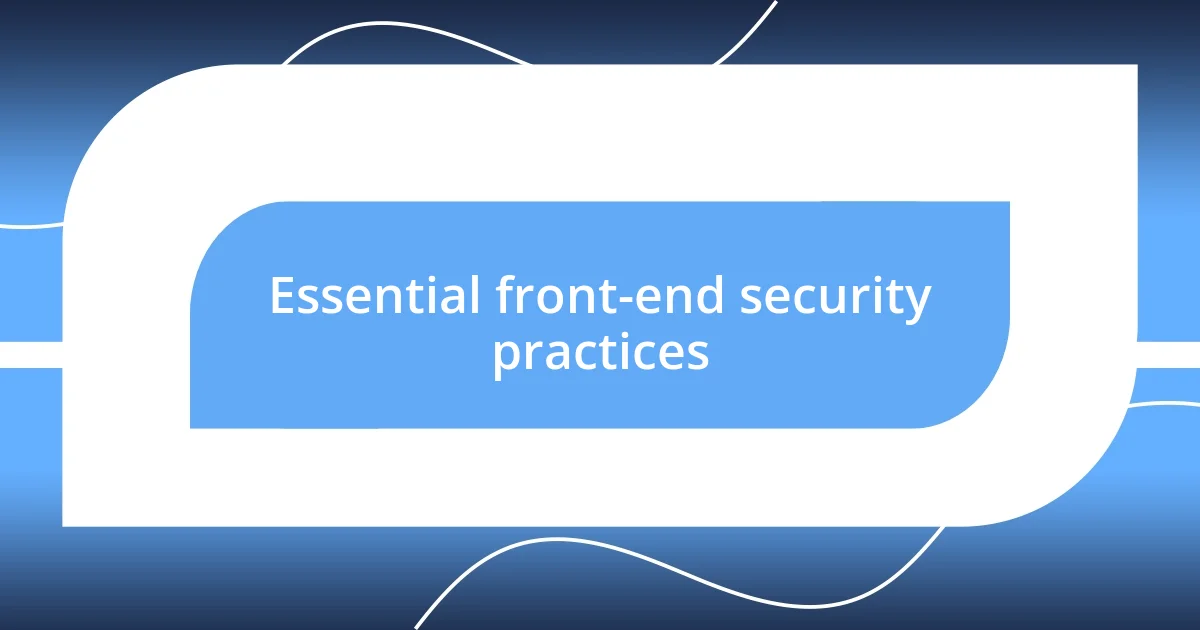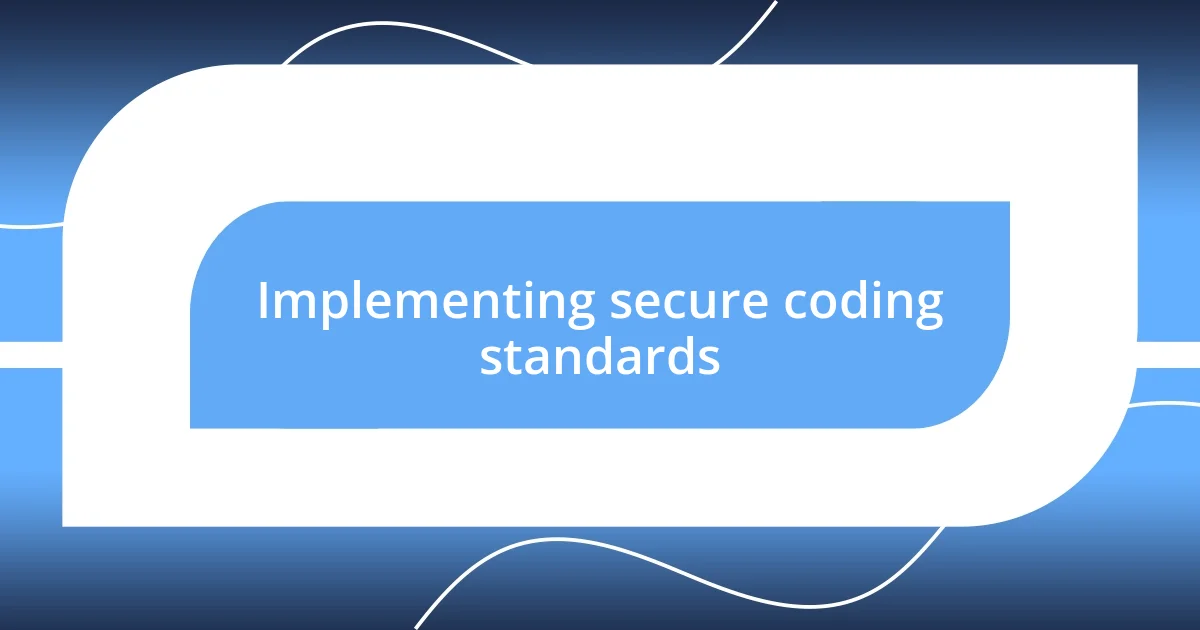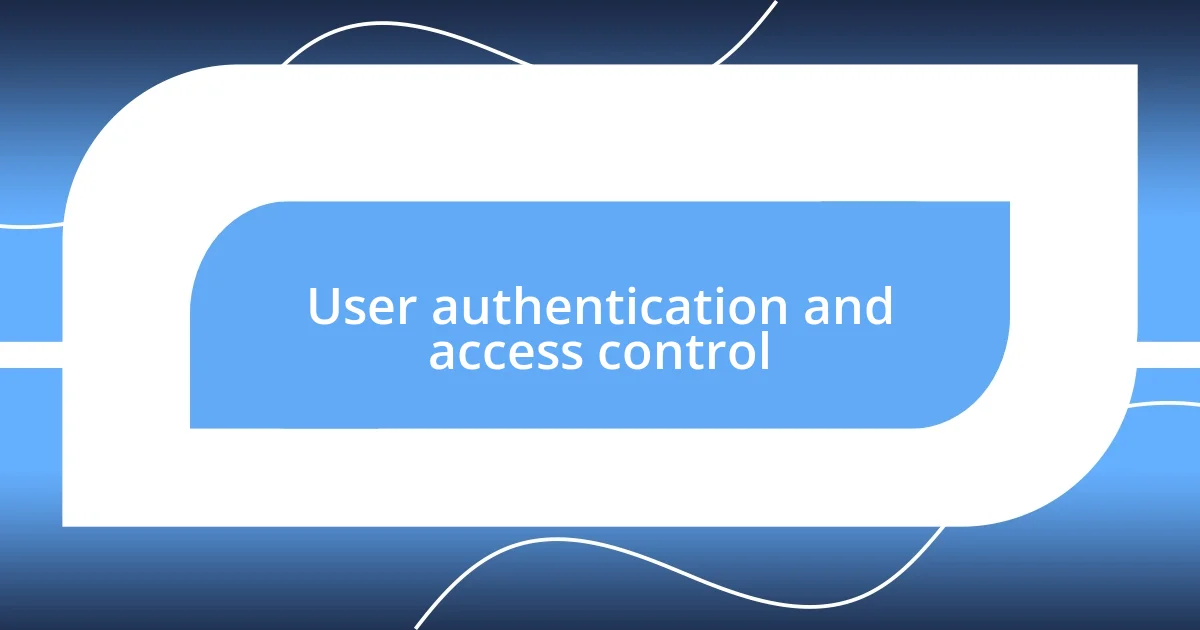Key takeaways:
- Front-end security threats like XSS and insecure APIs must be prioritized, highlighting the need for vigilant coding practices.
- Implementing essential practices, such as HTTPS, input sanitization, and adopting tools like Web Application Firewalls, can significantly enhance security.
- Future security trends, including machine learning and decentralized applications, alongside user education, are crucial for adapting to evolving threats.

Understanding front-end security threats
When I first got into web development, I quickly realized how vulnerable front-end environments can be. One of the biggest threats I encountered was cross-site scripting (XSS). It’s unsettling to think how a tiny piece of malicious code can turn a trusted website into a weapon against its users. Have you ever considered how often you interact with seemingly safe sites, and what could happen if they were compromised?
I remember a specific incident when a project I was working on was targeted by a UI redressing attack, which altered the way a legitimate page appeared. It felt like I was in a digital illusion, where everything looked normal on the surface, but the intentions were completely different. This experience reinforced my understanding that front-end vulnerabilities are often cleverly disguised, waiting for an unsuspecting user to give them access.
Moreover, the threat of insecure APIs haunts many developers and users today. It’s easy to overlook the fact that. APIs connecting the front-end to back-end services can be just as exposed as the user interface itself. Have you thought about the potential repercussions if an API endpoint is not properly secured? It’s a chilling reminder that while we focus on creating seamless user experiences, we must also diligently defend against an ever-evolving array of threats.

Essential front-end security practices
Ensuring front-end security is crucial, and it all starts with validating user inputs. In my own experience, I learned this the hard way when a simple oversight allowed an XSS vulnerability to slip through. By implementing strict validation on every input field, developers can catch potential threats before they morph into a significant issue. Always remember, prevention is much easier than dealing with the aftermath of a breach.
Here are some essential front-end security practices to incorporate into your workflow:
– Use HTTPS: Encrypt data transmitted between the client and server.
– Sanitize Input: Always clean user inputs to avoid code injection.
– Implement Content Security Policy (CSP): It adds an extra layer of protection against XSS attacks.
– Limit CORS (Cross-Origin Resource Sharing): Be cautious about which domains can interact with your API.
– Session Management: Ensure secure sessions by using cookies with the ‘HttpOnly’ and ‘Secure’ flags.
Each of these measures can feel a bit like layering an armor of security, and I assure you, the peace of mind that comes from knowing your site is fortified is worth the effort.

Best tools for enhancing security
Choosing the right tools for enhancing front-end security can be a game changer. I remember when I first integrated automated security scanning tools into my workflow. The sense of relief I felt was immense, knowing that potential vulnerabilities were being flagged before they reached production. Tools like Snyk and OWASP ZAP are invaluable for automatically identifying and addressing issues, allowing developers to focus on creating robust applications instead of constantly worrying about lurking threats.
Additionally, implementing Web Application Firewalls (WAF) can act as an essential line of defense. A WAF analyzes traffic to detect and block harmful requests, keeping the application safe from attacks such as XSS and SQL injection. When I deployed a WAF on my last project, I noticed an immediate drop in suspicious activity. It’s incredible how a little extra protection can create a much safer environment for both developers and users alike.
| Tool | Functionality |
|---|---|
| Snyk | Automated scans for vulnerabilities in both code and dependencies. |
| OWASP ZAP | Free security tool for finding vulnerabilities in web applications. |
| Web Application Firewall (WAF) | Monitors and filters traffic to safeguard applications from attacks. |
Another favorite of mine is the combination of security headers. I was once shocked to discover how simply setting the right HTTP headers, like X-Content-Type-Options and X-Frame-Options, could mitigate certain attack vectors. It’s astonishing how a few extra lines of configuration can bolster your defenses. Enhanced security is not always about complex solutions; sometimes, minimalist approaches can provide substantial results.

Implementing secure coding standards
Implementing secure coding standards is non-negotiable in today’s digital landscape. When I started my career, I didn’t realize how pivotal these standards were until a minor oversight in code allowed a serious vulnerability to emerge. It felt like a wake-up call, teaching me that every line of code must be scrutinized for security flaws because even small mistakes can open the door to major threats.
One practice I strongly advocate for is using code reviews and static analysis tools to ensure adherence to secure coding standards. I remember the first time I collaborated with a peer for a code review; I was amazed at how much I learned from their perspective. It’s not just about finding bugs, but also about fostering a culture where security is a shared responsibility. Think about it—wouldn’t you feel more secure knowing multiple eyes are on your code, dissecting it for potential dangers?
Incorporating these practices into your routine can feel overwhelming, but I assure you, it’s about creating habits. I try to remind myself that developing good coding standards is like laying down solid foundations for a house. Just as a house needs a strong foundation to stand firm against storms, secure coding standards provide the necessary safeguards to protect against the ever-evolving landscape of cyber threats. With each small step, we move closer to creating a secure environment for our applications and users.

User authentication and access control
User authentication is the first line of defense in securing any application. I once encountered a situation where a project I was involved in suffered due to weak password practices. When I implemented multi-factor authentication (MFA) for that application, it wasn’t just an added layer of security; it significantly boosted my team’s confidence in protecting user data. I often wonder, how many potential breaches could be prevented by just asking one more question during login?
Access control follows closely behind authentication, ensuring users have the appropriate permissions. There was a challenging moment in my career when I realized that careless access settings allowed many users entry to sections of our application they shouldn’t have. By implementing role-based access control (RBAC), I found a system that not only simplified management but also instilled a sense of safety. I sometimes ask myself—can we really afford to take access control lightly when it lays the groundwork for our applications’ integrity?
Moreover, regularly reviewing and updating authentication and access control mechanisms is essential. I recall a project where failure to audit access permissions led to outdated and unnecessary access points. When we conducted a quarterly review, the relief of identifying and rectifying those issues was palpable. It raised an intriguing thought in my mind—what’s the point of being secure if we don’t actively validate our defenses? Regular audits can illuminate vulnerabilities that may otherwise become lurking threats.

Common vulnerabilities and mitigation strategies
Cross-site scripting (XSS) is a prevalent vulnerability that can wreak havoc on user experience and data security. I learned this the hard way when a simple input field on one of my projects was exploited, leading to security breaches that affected our user base. It struck me that a thorough understanding of output encoding and input validation is vital, highlighting how essential it is to sanitize user inputs. Have you ever considered how a seemingly harmless text box could become a gateway for attackers?
Another common vulnerability is SQL injection, which allows attackers to manipulate databases through insecure queries. I vividly recall a project that faced major setbacks due to oversights in query construction. Implementing parameterized queries transformed our application’s defense against these types of attacks. It made me ponder how many developers might overlook such a straightforward practice while focusing on other complexities.
Lastly, I can’t stress the importance of Cross-Origin Resource Sharing (CORS) misconfigurations. One time, I witnessed a client’s application being exposed to unauthorized resource sharing due to lax CORS settings. Adjusting these configurations enhanced not only the application’s security but also the client’s trust in our abilities. It begs the question—don’t we owe it to our users to ensure their information is shielded from unintended access? Taking these vulnerabilities seriously can fortify our applications and reassure our users that their data is safe.

Future trends in front-end security
Emerging technologies are paving the way for more robust front-end security measures. I remember when I first encountered the concept of machine learning in security applications; it felt like finding a hidden treasure. With machine learning algorithms analyzing user behavior, it’s not just about detecting anomalies anymore—it’s about adapting to threats in real time. Isn’t it exciting to think about how these innovations could turn the tide against attackers?
Furthermore, the rise of decentralized applications (dApps) has introduced new security paradigms. I had my reservations initially, but experiments with blockchain technology opened my eyes to its potential for enhancing data integrity and user privacy. By decentralizing data storage, we can mitigate risks like data breaches and even reduce reliance on centralized servers. It prompts me to ask, how can we leverage these advancements to redefine security protocols in the front-end space?
Lastly, the emphasis on user awareness is gaining traction. I vividly recall interacting with users who were blissfully unaware of phishing tactics that targeted their personal data. As we evolve our security measures, shouldn’t we also focus on empowering users with education and resources? Elevating user awareness not only creates a safer environment but also reinforces the collective responsibility we share in the fight against cyber threats. This holistic approach, blending technology and education, might just be the key to achieving a secure future for front-end applications.














